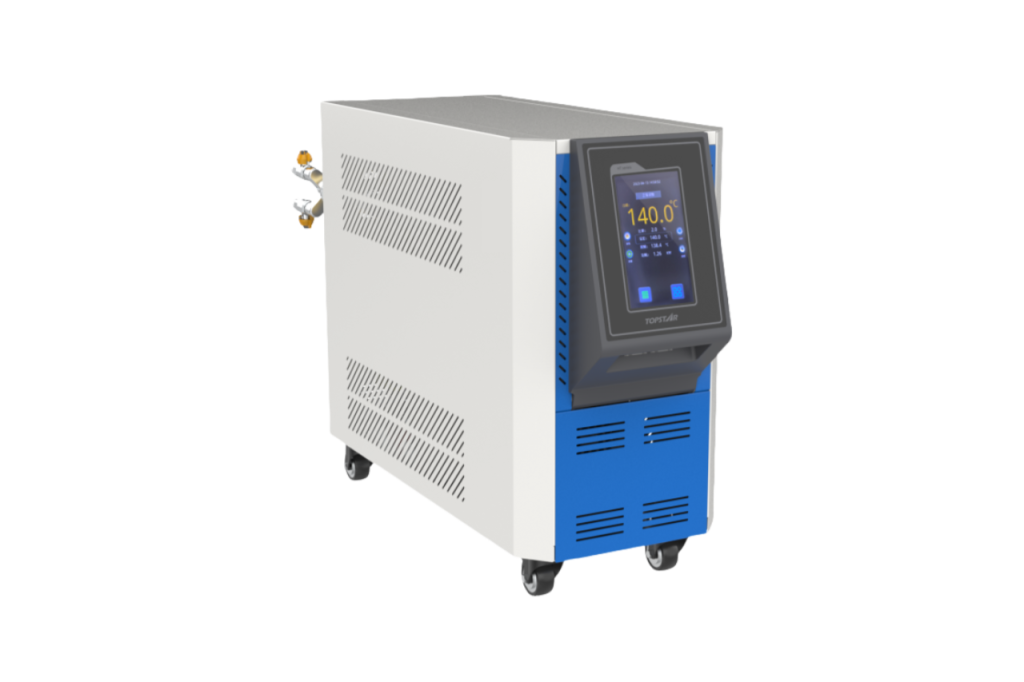How do we acceptance test mould temperature controller to ensure temperature uniformity and stability?
2025/10/06 By le zhan
.webp)
A 1°C deviation in mould temperature isn’t just a minor flaw; it can impact the quality of the finished product. The Society of Plastics Engineers (SPE) reports that inconsistent mould heating or cooling accounts for 22% of all injection moulding defects, costing US factories tens of thousands of dollars in material waste and downtime annually, from warping automotive parts to leaking packaging. Therefore, Topstar goes beyond simply testing mould temperature controller after they’re manufactured; we put them through a three-stage acceptance process designed to eliminate risk. Before final delivery, we conduct 48 hours of continuous operation, 10,000-level statistical system testing, and two full-cycle production simulations to ensure temperature uniformity and stability.
Setting Clear Standards for Mould Temperature Controller Performance
Before any testing begins, we establish measurable benchmarks. As a mould temperature controller manufacturer, Topstar aligns your specific needs with performance metrics. For example, is your process for producing thin-walled packaging requiring a temperature uniformity of ±0.5°C, or is it for producing large structural parts with a tolerance of ±1°C? What is the target heat-up time during mould changeovers? We then cross-reference this data with industry standards to develop a customised testing plan. For example, a customer producing HDPE bottles required their mould temperature controller to maintain a temperature of 90°C with no zero drift during a 6-hour run, so we built this tolerance into the benchmark test. This upfront work ensures our testing goes beyond simply guaranteeing performance and verifying the mould temperature controller’s suitability for your workflow, rather than simply testing in a lab.

48-Hour Continuous Run to Verify Mould Temperature Controller Stability
Every batch of our tested mould temperature controllers is run continuously for 48 hours to simulate the 24/7 production cycle that many plastics plants rely on. Shorter testing can miss gradual issues, such as heat exchanger performance degradation after 20 hours or electrical components causing minor temperature drift during ramp-up. During this phase, we monitor three key metrics every 5 minutes: mould inlet, outlet, and surface temperatures; heat transfer fluid pressure; and energy consumption. We recently conducted a 48-hour test for an automotive customer at 120°C for a PP part. This ensured fluctuations did not exceed ±0.3°C, well below the ±0.5°C limit, while fluid pressure remained stable and showed no signs of wear. If even the slightest temperature drift occurred in a particular unit, we paused the test to troubleshoot, fix the root cause, and restart the test.

Using a 10,000-degree statistical system testing for mould temperature uniformity
Uniformity, ensuring that every part of the mould maintains the target temperature, is just as important as stability. If the mould temperature controller reaches 150°C at the centre and 148°C at the edge, inconsistent parts will be produced. Therefore, we use 10,000-degree statistical system testing to collect 10,000 data points throughout the mould and fluid system to ensure consistent performance. We begin by placing 12 high-precision sensors (calibrated to ±0.1°C) in the mould cavity, fluid lines, and heating elements. Over eight hours, we recorded temperature readings every 2.88 seconds, accumulating 10,000 data points. We then used SPC to analyse variations. For example, for a medical plastics customer producing syringe barrels, testing revealed a tiny hot spot (150.7°C) that had been missed during the initial 48-hour test. We adjusted the heating element layout, retested, and achieved 99.9% of readings within ±0.3°C.
Two full-cycle simulations validated equipment readiness
Even mould temperature controllers that perform well in continuous operation need to adapt to the real-world production rhythm: heat, hold, cool, repeat. Our third phase simulated this process with two complete production cycles. Each cycle included:
- Heating: Ramp up from ambient to target temperature
- Hold: Maintain temperature for six hours (simulating a production shift)
- Cooling: Cool down to 40°C (for demolding or mould change)
- Restart: Repeat the cycle to test consistency.
We ran a 48-hour cycle for a consumer goods customer producing polypropylene bottle caps. The mould temperature controller reached 100°C in 9 minutes and maintained a uniformity of ±0.2°C. This phase ensures that the equipment is not only stable but also adaptable to fluctuations in your operations. If issues arise with heating speed or cooling efficiency, we refine the control algorithm or adjust components before continuing.
Documenting and Approving the Tested Equipment
Testing is meaningless without transparency. After completing all three phases, we compile a comprehensive report for you. We walk you through the report, answering questions like, “How did the equipment perform during the cooling phase?” or “What happens if our production run exceeds 6 hours?” Only after you approve the results do we consider the mould temperature controller “tested and ready.” For one packaging customer we worked with, this step revealed a slight deviation during the 48-hour test. We replaced a worn O-ring, retested, and shared the updated data before delivery.

Ensuring Customer Success Through Rigorous Testing
For plastics manufacturers, reliable mould temperature controllers are the cornerstone of consistently high-quality production. Topstar’s acceptance testing includes 48 hours of continuous operation, 10,000-level statistical testing, and two full-cycle simulations—more than just a series of steps, it’s a commitment. We test our mould temperature controllers the way you use them: continuously under real-world conditions, taking your specific needs into account, ensuring continuous production.
TRENDING POSTS
- TOPSTAR Global Open Day 2025: Humanoid Robot Debuts, Pioneering a New Decade of Intelligent Manufacturing 2025/10/06
- Topstar Showcases TE II Electric Injection Molding Machines at InterPlas Thailand 2025 2025/10/06
- Topstar Expands Its Ecosystem Partnerships to Drive Smart Manufacturing Innovation 2025/10/06
- What factors can cause delays in the injection molding process of plastic molding machine? 2025/10/06
HOT TOPIC
- .ervo motor-driven linear robots
- •
- 1.0 guangdong topstar technology co. ltd
- 1.0 topstar china
- 1.0 topstar robot
- 11
- 160℃ mold temperature controller
- 170 ton injection molding machine
- 2
- 21
- 220-ton injection molding machine
- 23
- 3 axis robot
- 3 axis robots
- 3 in 1 Compact Dehumidifying Dryer
- 3-axis robot
- 3-axis robots
- 39
- 41
- 460T injection molding machine
- 5-axis CNC machine
- 62
- 90 ton injection molding machine
- accuracy
- Air Chillers
- all electric injection molding machine
- all electric injection molding machines
- all-electric injection molding machine
- All-electric injection molding machines
- and overall production quality. Therefore
- AP-RubberPlas
- automated injection molding machine
- Automation changed engineering
- automation of injection molding robots
- automotive parts injection molding
- auxiliary machine
- Bench Injection Molding Machine
- Cabinet dryer manufacturers
- Cabinet dryers
- chiller
- CNC Drilling Machine
- CNC Drilling Machines
- cnc engraving machine manufacturer
- cnc laser cutting machine manufacturer
- CNC machine
- CNC Machine Center
- CNC Machine for Sale
- CNC Machine Manufacturing
- CNC Machine Tool
- CNC machine tool product
- CNC Machining Center
- CNC wood carving machine
- Cooling system
- Cross-Walking Single Axis Servo Cylinder Robot
- Cross-Walking Single-Axis Servo Cylinder Robot
- Cross-Walking Three-Axis/Five-Axis Servo Driven Robot
- cross-walking three-axis/five-axis servo-driven robot
- Dehumidifier Dryer
- Dehumidifying Dryer
- delta parallel robot
- Desktop Injection Molding Machine
- Desktop injection molding machines
- Desktop Molding Machine
- desktop plastic injection machine
- Desktop Plastic Injection Molding Machine
- Digital Transformation
- direct clamp injection molding machine
- Direct clamp injection molding machines
- Dosing & mixing system
- Drilling Centers
- Drying and dehumidification system
- drying and dehumidifying equipment
- Drying and Dehumidifying System
- drying system
- effective and efficient. Cabinet dryers are also used in other industries where large quantities of material need to be dried
- efficient injection molding machine
- elbow hydraulic injection molding machines
- electric injection molding machine
- electric injection molding machines
- energy-efficient injection molding robot
- energy-efficient water chiller
- energy-efficient water chillers
- energy-saving injection molding machine
- etc. Among injection molding robots
- exhibition
- features of CNC machine
- Feeding And Conveying System
- Five Axis Machine Center
- Flexible Production Line
- Fully automatic injection molding machine
- Gathering Topstar
- giant injection molding machine
- GMU-600 5-Axis Machining Center
- Granulating & Recycling System
- Heavy duty injection molding machine
- High-precision electric molding machines
- high-precision plastic molding machines
- high-speed all electric injection molding machine
- high-speed electric injection molding machine
- High-Speed Packaging Injection Molding
- Honeycomb rotor dehumidifier
- horizontal injection molding machine
- Horizontal Injection Molding Machines
- Horizontal Injection Moulding Machine
- Horizontal Mixer manufacturer
- How The CNC Machine Works
- hybrid injection molding machine
- hydraulic injection molding machine
- Hydraulic Injection Molding Machines
- in this article
- Industrial AI
- Industrial Automation
- Industrial robot
- Industrial Robot Chinese brand
- industrial robot parts
- industrial robot supplier
- Industrial robots
- Industry Chain
- Injection Manipulator
- injection manipulator robot
- injection mold machines
- Injection molding
- Injection molding automation
- Injection Molding Automation Solution
- injection molding dryer
- Injection molding equipment
- injection molding hopper dryer
- Injection molding machine
- injection molding machine brand
- Injection Molding Machine Factory
- Injection Molding Machine Manufacture
- Injection molding machine manufacturer
- injection molding machine manufacturers
- Injection molding machine procurement
- injection molding machine robotic arm
- injection molding machine with a robot
- Injection molding machines
- injection molding material dehumidifying
- injection molding plant
- injection molding process
- Injection Molding Robot
- injection molding robot arm
- Injection molding robot automation
- Injection molding robotic arm
- injection molding robots
- Injection moulding machine
- injection moulding machines
- Injection Moulding Robots
- Injection Robot
- Injection robot arm
- Injection robot manufacturer
- Injection robot wholesale
- injection robots
- Intelligent Factory
- intelligent injection molding machines
- Intelligent Manufacturing
- intelligent mold temperature
- intelligent mold temperature controller
- Intelligent mould temperature controller
- InterPlas Thailand 2025
- Introducing Injection Robot
- It is the best choice for drying large quantities of material at once. Cabinetmakers use these machines because they are fast
- Large flow water type mold temperature controller
- large injection molding machine
- large injection molding machines
- Learn what industrial automation and robotics is
- linear robot
- linear robots
- low speed sound-proof granulator
- machine plastic molding
- make sure to add some! Improvements (2) Keyphrase in introduction: Your keyphrase or its synonyms appear in the first paragraph of the copy
- manipulator machine
- manufacturing
- Manufacturing Innovation
- medical grade injection molding machines
- Medical Injection Molding
- medical injection molding machine
- medical injection molding machines
- micro injection molding machine
- middle speed granulator
- Mini CNC machine manufacturers.
- mobile cover making machine
- Mold Temperature Control System
- mold temperature controller
- mold temperature controllers
- molding machine
- molding material Dehumidifying System
- mould temperature control system
- mould temperature controller
- mould temperature controllers
- New electric injection molding machine
- nitrogen dryer manufacturer
- nitrogen dryer system manufacturer
- Oil type mold temperature controller
- Oil type mold temperature controllers
- open day
- optical component injection molding
- Outbound links: No outbound links appear in this page. Add some! Images: No images appear on this page. Add some! Internal links: No internal links appear in this page
- packaging injection molding
- Packaging Solutions
- PET Preform injection molding
- phone case maker machine
- phone case making machine
- phone cover making machine
- plastic bottle making machine
- plastic bottle manufacturing
- plastic bucket making machine
- plastic bucket manufacturing
- Plastic chair making machine
- plastic forming equipment
- plastic hopper dryer
- plastic injection machine
- plastic injection machines
- plastic injection molding
- Plastic injection molding equipment
- Plastic injection molding machine
- Plastic Injection Molding Machines
- plastic injection moulding machine
- plastic injection moulding machines
- plastic injection robot
- plastic molding
- Plastic Molding Industry
- Plastic Molding machine
- plastic molding machine 1
- Plastic Molding Machines
- plastic molding press
- plastic moulding machine
- plastic phone case making machine
- plastic-molding machine
- powerful granulator
- Powerful Type Sound-Proof Granulator
- precision injection molding
- precision injection molding machines
- production of plastic seats
- pure water mould temperature controller
- Robot injection molding
- robot injection molding machine
- robot manufacturing companies
- Robotic arm for injection molding machine
- robotic injection molding machines
- robotics in injection molding
- SCARA robot
- SCARA robots
- Service-oriented manufacturing
- Servo Cylinder Robot
- servo driven robot
- Servo Driven Robots
- servo injection molding machine
- servo injection robots
- servo motor-driven linear robots
- servo-driven 3-axis robot
- Servo-Driven Robot
- Setup of injection machine
- Silicone Injection Molding Machine
- six-axis industrial robot
- Smart Manufacturing
- Stainless Hopper Dryer
- Stainless Hopper Dryers
- star club
- swing arm robot
- take-out robot
- take-out robots
- Thailand 4.0
- the choice between servo-driven robots and hydraulic robots will have a certain impact on efficiency
- the most popular injection molding machine
- the type of injection molding robot
- TIC2000 Control System
- TMII injection molding machine
- toggle clamp injection molding machine
- Toggle Hydraulic Injection Molding Machines
- toggle injection molding machine
- Top 10 brands of injection robots
- Topstar
- Topstar Electric Injection Molding Machine InterPlas Thailand 2025 Smart Manufacturing Thailand 4.0
- Topstar Engineering
- Topstar Industrial Robots
- Topstar injection molding intelligent
- Topstar Scara Robots
- Useful Injection molding machine
- Vertical machining centers
- volumetric type blender
- water chiller
- water chillers
- water distributor
- water type mold temperature controller
- Water Type MoldTemperature Controller
- Water-Type Mould Temperature Controllers
- We often face choices when performing injection molding. We will choose the type of injection molding machine
- wholesale of injection molding machines
- x carve CNC
- 热门查询 点击次数 展示 排名 topstar
